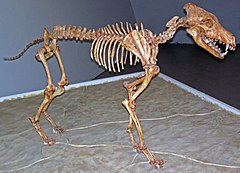
Back Reusewolf Afrikaans ذئب رهيب Arabic Aeonocyon dirus Azerbaijani Свиреп вълк Bulgarian ভয়াবহ নেকড়ে Bengali/Bangla Llop gegant Catalan Canis dirus CEB Pravlk obrovský Czech Aenocyon dirus German Ανταρόλυκος Greek
| Dire wolf Temporal range:
| |
|---|---|

| |
| Mounted skeleton, Sternberg Museum of Natural History | |
| Scientific classification | |
| Domain: | Eukaryota |
| Kingdom: | Animalia |
| Phylum: | Chordata |
| Class: | Mammalia |
| Order: | Carnivora |
| Family: | Canidae |
| Subfamily: | Caninae |
| Tribe: | Canini |
| Subtribe: | Canina |
| Genus: | †Aenocyon Merriam, 1918[2] |
| Species: | †A. dirus
|
| Binomial name | |
| †Aenocyon dirus | |
| Subspecies[3] | |
| Synonyms | |
The dire wolf (Aenocyon dirus[10] /iːˈnɒsaɪ.ɒn ˈdaɪrəs/) is an extinct canine. The dire wolf lived in the Americas (with a possible single record also known from East Asia) during the Late Pleistocene and Early Holocene epochs (125,000–9,500 years ago). The species was named in 1858, four years after the first specimen had been found. Two subspecies are recognized: Aenocyon dirus guildayi and Aenocyon dirus dirus. The largest collection of its fossils has been obtained from the Rancho La Brea Tar Pits in Los Angeles.
Dire wolf remains have been found across a broad range of habitats including the plains, grasslands, and some forested mountain areas of North America, the arid savanna of South America. The sites range in elevation from sea level to 2,255 meters (7,400 ft). Dire wolf fossils have rarely been found north of 42°N latitude; there have been only five unconfirmed reports above this latitude. This range restriction is thought to be due to temperature, prey, or habitat limitations imposed by proximity to the Laurentide and Cordilleran ice sheets that existed at the time.
The dire wolf was about the same size as the largest modern gray wolves (Canis lupus): the Yukon wolf and the northwestern wolf. A. d. guildayi weighed on average 60 kilograms (132 lb) and A. d. dirus was on average 68 kg (150 lb). Its skull and dentition matched those of C. lupus, but its teeth were larger with greater shearing ability, and its bite force at the canine tooth was stronger than any known Canis species. These characteristics are thought to be adaptations for preying on Late Pleistocene megaherbivores, and in North America, its prey is known to have included western horses, ground sloths, mastodons, ancient bison, and camels. Its extinction occurred during the Quaternary extinction event along with its main prey species. Its reliance on megaherbivores has been proposed as the cause of its extinction, along with climatic change and competition with other species, or a combination of those factors. Dire wolves lived as recently as 9,500 years ago, according to dated remains.
- ^ a b c Cite error: The named reference
leidy1858was invoked but never defined (see the help page). - ^ Cite error: The named reference
merriam1918was invoked but never defined (see the help page). - ^ a b Cite error: The named reference
kurten1984was invoked but never defined (see the help page). - ^ Cite error: The named reference
leidy1854was invoked but never defined (see the help page). - ^ Cite error: The named reference
leidy1869was invoked but never defined (see the help page). - ^ Cite error: The named reference
allen1876was invoked but never defined (see the help page). - ^ AMEGHINO, F. 1902. Notas sobre algunos mamíferos fósiles nuevos ó poco conocidos del valle de Tarija. Anales del Museo Nacional de Buenos Aires, 3º serie, 1:225–261
- ^ Cite error: The named reference
sellards1916was invoked but never defined (see the help page). - ^ Cite error: The named reference
frick1930was invoked but never defined (see the help page). - ^ From Greek αἰνός (ainós) 'dreadful' + κύων (kúōn) 'dog' and Latin dīrus 'fearsome'
© MMXXIII Rich X Search. We shall prevail. All rights reserved. Rich X Search